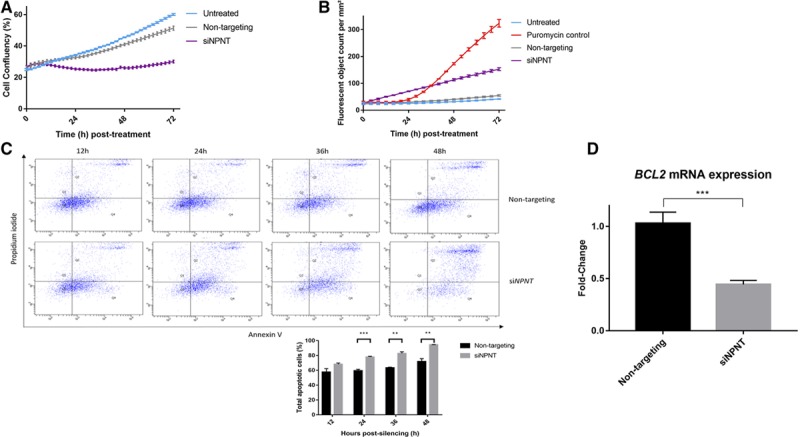Figure 6.

NPNT (nephronectin) protects H295R cells from apoptosis. A, NPNT silencing causes cell confluency to remain low over 72 h, as measured by kinetic live-cell imaging in groups that are untreated or treated with nontargeting siRNA (n=3; P<0.0001 between siNPNT and nontargeting). B, NPNT silencing drives active cell death, as shown by kinetic measurement of cytotoxicity using YOYO-1 iodide reagent, comparing number of fluorescent (dead) cells in groups that are untreated, treated with positive control puromycin, nontargeting siRNA, or specific siRNA against NPNT (n=4; P<0.0001 between siNPNT and nontargeting). C, NPNT silencing causes cell death via apoptosis, as shown by flow cytometric analysis using annexin V-APC and propidium iodide double staining in groups that are treated with nontargeting siRNA or specific siRNA against NPNT. Quadrant analysis of the gated cells in FL-1 versus FL-2 channels was from 10 000 events. Annexin V+/PI− (lower right quadrant) areas stand for early apoptotic cells, and Annexin V+/PI+ (upper right quadrant) areas stand for late apoptotic or necrotic cells. Graph below shows percentage of total apoptotic cells at 12, 24, 36, and 48 h post-silencing. D, NPNT silencing causes apoptosis through reduction of BCL2, a prosurvival factor in the intrinsic apoptotic pathway, as shown by mRNA expression in groups that are treated with nontargeting siRNA or specific siRNA against NPNT (n=6). Bars represent mean expression per group±SEM. Statistical analyses were conducted by Student t test. *P<0.05; **P<0.005; ***P<0.0005.
